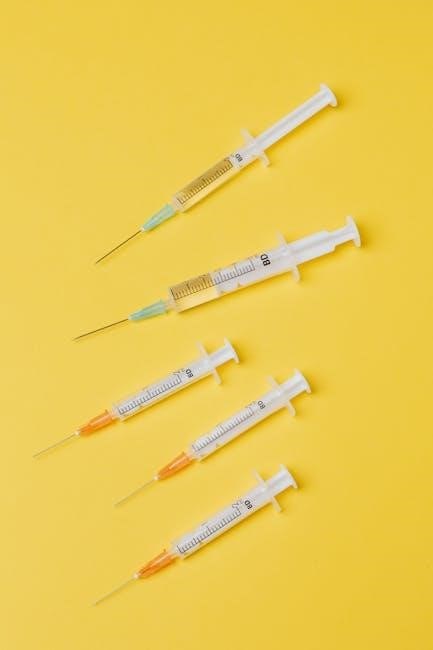Fluoroscopy guided injection is a medical procedure using real-time x-ray images to guide injections, with
- key benefits
including improved accuracy and reduced complications, as reported on the internet today at 19:07:39.
Definition and Purpose
Fluoroscopy guided injection is defined as a medical procedure that utilizes real-time x-ray images to guide the injection of medications into a specific joint or area of the body. The purpose of this procedure is to provide accurate and effective delivery of medications, such as corticosteroids or anesthetics, to reduce inflammation and alleviate pain. According to information available on the internet, this procedure is commonly used to treat various conditions, including osteoarthritis and other joint-related disorders. The use of fluoroscopy guidance allows for precise placement of the needle, minimizing the risk of complications and ensuring optimal outcomes. With the help of fluoroscopy, healthcare professionals can visualize the injection site and surrounding structures in real-time, enabling them to make adjustments as needed to achieve the desired results. This procedure has become an essential tool in the management of joint-related pain and inflammation, offering a safe and effective treatment option for patients. The definition and purpose of fluoroscopy guided injection are closely related to its clinical applications and benefits.
Indications and Contraindications
Fluoroscopy guided injection is indicated for various conditions, including osteoarthritis, joint pain, and inflammation. The procedure is commonly used to treat pain associated with arthritis, as well as other joint-related disorders. According to information available on the internet, the indications for fluoroscopy guided injection include several potential conditions, usually to treat pain from osteoarthritis. On the other hand, contraindications for the procedure include certain medical conditions, such as active infection or bleeding disorders. Additionally, patients with pacemakers or other implantable devices may not be suitable candidates for fluoroscopy guided injection. A thorough evaluation of the patient’s medical history and current health status is necessary to determine the suitability of the procedure. The indications and contraindications of fluoroscopy guided injection are crucial in ensuring the safe and effective use of the procedure. By carefully selecting patients who are likely to benefit from the procedure, healthcare professionals can optimize outcomes and minimize risks. The internet provides a wealth of information on the indications and contraindications of fluoroscopy guided injection.

Procedure Details
Fluoroscopy guided injection involves real-time x-ray images and specialized equipment to ensure accuracy and safety, with a focus on precise injection techniques and patient comfort, using various medical tools and supplies.
Equipment and Supplies
The equipment and supplies used for fluoroscopy guided injection include a fluoroscopy machine, which provides real-time x-ray images, and a range of medical tools such as needles and syringes.
A contrast dye is also used to confirm the accuracy of the injection, and a combination of anesthetic and anti-inflammatory medication is administered to ensure patient comfort and relief.
The use of specialized equipment, such as a bent 22g quincke needle and a 3cc syringe, is also common in these procedures, as reported on the internet today.
Additional supplies, including gloves and sterile drapes, are used to maintain a sterile environment and minimize the risk of complications.
The specific equipment and supplies used may vary depending on the individual patient and the nature of the procedure, but the goal is always to ensure accuracy, safety, and effective treatment.
The equipment is designed to work together to provide a safe and effective treatment option for patients, and to help physicians determine the best course of treatment for their patients.
Step-by-Step Process
The fluoroscopy guided injection process involves several key steps, starting with patient preparation and positioning.
The patient is typically placed on an examination table and the affected area is cleaned and sterilized.
A small needle is then inserted into the joint or affected area, using real-time x-ray images to guide the needle to the correct location.

A contrast dye is injected through the needle to confirm the accuracy of the injection, and then a combination of anesthetic and anti-inflammatory medication is slowly injected into the joint.
The entire process is monitored using fluoroscopy, allowing the physician to adjust the needle position and medication dosage as needed.
The procedure is typically quick, usually taking only a few minutes to complete, and is often performed on an outpatient basis.
The step-by-step process is designed to ensure accuracy and safety, and to provide effective treatment for patients suffering from joint pain and inflammation.
The use of fluoroscopy guidance allows for precise placement of the medication, increasing the likelihood of successful treatment.

Radiation Exposure and Safety
Fluoroscopy guided injection uses x-ray technology with minimal radiation exposure to patients and healthcare providers, ensuring a safe procedure with
- proper precautions
in place always.
Radiation Exposure
Fluoroscopy guided injection utilizes x-ray technology, which inherently involves radiation exposure, however, the equipment is designed to minimize this exposure to both patients and healthcare providers. The procedure’s duration and frequency of x-ray images contribute to the overall radiation dose. According to internet reports, the radiation exposure during fluoroscopy guided injections is generally considered low. This is due to the use of pulsed fluoroscopy, which reduces the dose of radiation. Additionally, the x-ray beam is tightly collimated to focus on the specific area of interest, further reducing radiation scatter. The benefits of fluoroscopy guided injections, including improved accuracy and reduced complications, often outweigh the risks associated with radiation exposure. As a result, fluoroscopy guided injections are considered a safe and effective procedure for various medical applications, with proper precautions in place to minimize radiation exposure. Overall, the radiation exposure associated with fluoroscopy guided injections is carefully managed to ensure a safe procedure.
Safety and Efficacy
Fluoroscopy guided injections are considered safe and effective procedures, with a low risk of complications. The use of real-time x-ray images allows for precise placement of the needle, reducing the risk of injury to surrounding tissues. According to internet reports, the efficacy of fluoroscopy guided injections is well-established, with studies demonstrating significant improvements in patient outcomes. The safety profile of these procedures is also well-documented, with few reported adverse events. Factors contributing to the safety and efficacy of fluoroscopy guided injections include the skill and experience of the practitioner, as well as the use of proper technique and equipment. Overall, the combination of safety and efficacy makes fluoroscopy guided injections a valuable tool in the management of various medical conditions. With proper training and adherence to established protocols, healthcare providers can confidently perform these procedures, providing patients with effective and minimally invasive treatment options. The safety and efficacy of fluoroscopy guided injections have been extensively studied and validated.

and Future Directions
Fluoroscopy guided injection techniques continue evolving with advances in technology and medicine, offering improved patient outcomes and treatment options, as reported on the internet, with future research and developments anticipated, slowly.
Fluoroscopy guided injection offers numerous benefits, including improved accuracy and reduced complications, as well as the ability to provide real-time images, allowing for more precise injections. The use of fluoroscopy guided injection also enables healthcare professionals to confirm the correct placement of the needle, reducing the risk of misinjection. Additionally, this technique can be used to treat a variety of conditions, including arthritis and other joint-related pains. With the help of fluoroscopy guided injection, patients can experience significant pain relief and improved mobility. The procedure is also relatively quick and can be performed on an outpatient basis, making it a convenient option for patients. Overall, fluoroscopy guided injection is a safe and effective treatment option, with a high success rate and minimal side effects. The benefits of fluoroscopy guided injection make it an attractive option for patients seeking relief from joint pain and inflammation, with many healthcare professionals recommending this procedure.
Future Research and Developments
Future research on fluoroscopy guided injection is expected to focus on improving the accuracy and safety of the procedure, with the use of advanced imaging technologies and techniques. New developments in the field of fluoroscopy guided injection may include the use of artificial intelligence and machine learning algorithms to enhance image guidance and improve patient outcomes. Additionally, researchers may explore the use of fluoroscopy guided injection for new indications, such as treating chronic pain and inflammation in other parts of the body. The development of new medications and therapeutic agents may also be investigated, with the goal of improving the efficacy and duration of pain relief. Furthermore, studies may be conducted to compare the effectiveness of fluoroscopy guided injection with other treatment options, such as physical therapy and surgery. Overall, future research and developments in fluoroscopy guided injection are expected to lead to improved patient care and outcomes, with a focus on minimizing risks and maximizing benefits. New technologies and techniques will continue to emerge, shaping the future of this medical procedure.